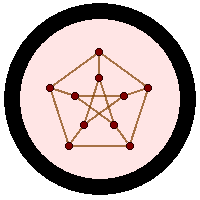As detailed on the syllabus, your content grade in this course will be determined by your proficiency on a variety of standards. (This is known as Standards Based Grading.)
The list of standards will grow throughout the semester.
Unassessed Standards
[Note: Standards A and B will not be assessed directly. However, you must be proficient with them in order to answer questions related to the other standards.]Standard A. Standard Graph Terminology. I am fluent with the graph theory definitions presented in class and highlighted in bold throughout the notes.
Standard B. Standard Graph Examples. I am fluent with the infinite families of graphs and special graphs presented in class. This includes the path, cycle, complete, complete bipartite, wheel, star, and cube graphs, the Platonic solid graphs, and the Petersen and Grotzsch graphs.
Assessed Standards
Standard 1. Degree Sequences. I understand the definition of a degree sequence of a graph. I understand how to prove Theorem 1.1.1 and its ramifications. I can determine if a sequence is graphic. I can provide a graph that has a given degree sequence. I can apply the Havel-Hakimi algorithm.
Standard 2. Isomorphisms. I understand the definition of graph isomorphism. I can prove that two graphs are isomorphic or not isomorphic.
Standard 3. Constructions. I can apply graph constructions such as the (edge) union, (disjoint) union, graph complement, induced subgraph. I can determine whether one graph is a subgraph of another graph.
Standard 4. Trees and Forests. I can determine when a graph is connected from the definition and from numerical considerations. I know the definition of a tree and a forest. I know and can apply the numerical relationship between the number of vertices and edges thereof.
Standard 5. Coloring. I can find a proper coloring of a graph. I can determine the chromatic number of a graph. I can determine if a graph is critical. I can determine if a graph is a bipartite graph.
Standard 6. Edge coloring. I can determine the chromatic number of a graph. I can determine whether a cubic graph is a snark. I understand the turning trick argument.
Standard 7. Cycles. I can find a Hamiltonian cycle in a graph or prove that one does not exist. I understand how Hamiltonian cycles apply to knight's tours. I understand the key arguments in the proof of when closed knight's tours do not exist.
Standard 8. Circuits. I understand the terminology for different types of walks in a pseudograph. I know when an Eulerian circuit and a Eulerian trail exists in a pseudograph. I can find an Eulerian circuit or Eulerian trail in a given pseudograph. I understand how Eulerian circuits apply to de Bruijn sequences.
Standard 9. Planarity and Numerical Data. I can determine if a graph is planar. I understand the proof of Euler's formula and know when it applies. I understand the concept of a maximal planar graph and understand how this leads to a numerical bound on planarity. I understand the equivalent argument for graphs of higher girth.
Standard 10. Planarity and Duality. I can determine the dual (pseudo-)graph to a plane drawing of a planar graph. I understand how one graph may have multiple dual graphs. I understand the relationship between a graph and its dual, including the relationship between a maximal planar graph and a normal map.
Standard 11. Four Color Theorem. I understand the difference between a map coloring and a vertex coloring. I know and can apply the statement of the Four Color Theorem. I understand the Kempe Chains argument from the Five Color Theorem and why it fails to prove the Four Color Theorem.
Standard 12. Graph Modifications and Planarity. I understand the definitions of a subdivision of a graph and a minor of a graph. I can determine if one graph is a minor of another graph. I can determine if a graph is non-planar using Kuratowski's Theorem.
Standard 13. Maximality and Matchings. I understand the difference between a maximal property and a maximum property. I understand the concept of a matching and a perfect matching. I can determine if a matching is maximal.
Standard 14. Hungarian Algorithm. I understand the definition of an algorithm and what it means for an algorithm to be correct. I know the steps of the Hungarian Algorithm. I can apply the Hungarian Algorithm to find a maximum matching in a bipartite graph. I can explain why the Hungarian Algorithm must terminate and why it gives a maximum matching.
Standard 15. Gale-Shapley Algorithm. I know when a perfect matching is a stable marriage. I know the steps of the Gale-Shapley Algorithm. I can apply the Gale-Shapley Algorithm to find a set of stable marriages. I can explain why the Gale-Shapley Algorithm must terminate and why it outputs stable marriages. I understand what it means for a set of stable marriages to be human-optimal or pet-optimal.
Standard 16. Network Definitions. I understand the definitions surrounding network flow—capacity, flow, throughput, st-cut. I understand the definitions of the Maximum Flow Problem and Minimum Cut Problem, and I understand how the answers to those two problems are related.
Standard 17. Ford-Fulkerson Algorithm. I know the steps of the Ford-Fulkerson Algorithm. I can apply the Ford-Fulkerson Algorithm to find a maximum flow on a network. I can explain why the Ford-Fulkerson Algorithm must terminate and why it outputs a maximum flow.
